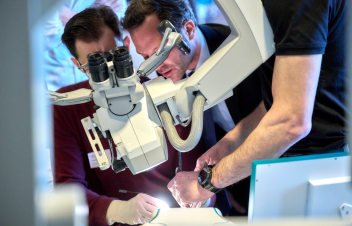Cutting-Edge Training: How Surgical Simulators Improve Patient Outcomes
- surgeonslab1
- May 24, 2024
- 4 min read

Neurosurgery is a highly specialized field that requires incredible accuracy and dexterity from its practitioners. Conventionally, the teaching of residents involved user practical training as residents followed the apprenticeship method with attending surgeons in operating theaters (OR). However, issues with staff experience because of areas such as patient safety and that of residents working many hours have made it compulsory to look for other training models. Surgical simulation can be described as a revolutionary technique used in neurosurgical education and also as a critical factor that has – positively – impacted the outcomes of neurosurgical operations.
The Role of Simulation in Neurosurgical Training
If we examine the apprenticeship model closely, though it has potential, it can also have its downside. Some county hospitals may lack adequate practice in complex procedures for live patients for safety reasons. Simulation-based training fills this gap by enabling the residents to practice surgical techniques in a safe environment.
These simulations come in various forms, including virtual reality (VR) platforms that can simulate real-life surgeries, 3D anatomical models designed to practice specific movements, and haptic feedback systems that simulate touch during the surgery (as seen in the studies published in the Journal of Neurosurgery).
Simulated training can be effectively used as a means of a work training practice because the application of such practice has been proven to be effective through previous research. Several studies indicate that simulation enables residents to develop mastery through higher-reliability practice, that is, a kind of rehearsal that practices can perform repeatedly without risking harm to a patient. It helps in muscle memory and builds up hand-to-eye coordination, which is critical to performing accurate movements within the operating room.
Advantages of Simulation-Based Training
The biggest strength of simulation-based training is that it allows an individual to carry out functions that are often performed in great danger in a controlled environment. Real patients can apply for the operation that the residents have been practicing on the virtual ones, and this way, they could be prepared to face those difficulties with real virtual patients. Not only does this increase patient advocacy and resident satisfaction, but it also helps ensure the safety of the residents.
Furthermore, simulation allows for deliberate practice, enabling residents to refine their skills through repetition. Unlike the operating room, where opportunities for specific procedures may be limited, simulation provides a platform to practice maneuvers repeatedly until proficiency is achieved. Studies have shown that simulation training can lead to improved technical skills as assessed by standardized evaluations.
The simulation also has the potential to be used for the evaluation and validation of technical competencies. Specific clinical situations can be standardized, and a resident can be rated against this standard when carrying out particular procedures. Therefore, it is possible to assert that using the proposed approach as an addition and a supplement to the classic assessment methods can be effective in providing a more objective assessment of a resident’s surgical skills.
The potential benefits of simulation go beyond the formation of skills among the personnel. Simulation studies have also indicated that intraoperative training decreases errors and the time that operatives take to carry out the operations. This translates into positive impacts in terms of patient care because patients take a shorter time to recover with fewer complications.
Impact on Patient Outcomes
The correlation between simulation training and improved surgical performance in the OR is becoming increasingly evident. Studies have shown that residents who undergo simulation training demonstrate better technical skills and improved decision-making during real surgeries. This translates to safer procedures and potentially better patient outcomes.
Apart from its function of enhancing the training of residents, simulation can be useful in other ways of preventing surgeon skill and competence from diminishing as a surgeon continues to work. Continuous practice in simulation enhances interactions among experienced surgeons, who are enabled to update their skills regarding the current techniques and practices in surgeries, aspects that add value to patient care delivery.
Best Neurosurgery Residency Programs Embracing Simulation
Many of the best neurosurgery residency programs in the United States are adopting simulation in their education model. These programs can be distinguished by the availability of many complex simulators for training, including VR platforms, benchtop models, and haptic feedback systems.
Many set aside for simulation training and more importantly incorporate it in the didactic and clinical model of the residency training program. Also, some programs have strong research to provide the latest simulation-based technologies and strategies to further improve the graduate medical education for residents.
Challenges and Future Directions
While the benefits of simulation-based training are undeniable, there are limitations to consider. The cost of developing and maintaining sophisticated simulators can be a barrier for some programs. Additionally, achieving a truly realistic surgical experience through simulation remains a challenge. Furthermore, the quality of research on the impact of simulation on patient outcomes needs further improvement.
Nevertheless, simulation practice appears to be a burgeoning area of growth. About it researchers continue to work on improving haptic feedback, the visuals in the simulators and their compatibility with artificial intelligence. The use of AI solutions can give the citizens immediate feedback, which will also vary the difficulty level of the simulation based on the abilities of the person.
Conclusion
Surgical simulation has changed the way neurosurgical residents are trained and educated, finally providing a safe way to train technical skills. The evidence is clear: simulation training equates to enhanced surgical competence, fewer mishaps, and overall favorable results for the patient. Broad and continuous disbursing of funds to improve simulators and training techniques are vital for the enhancement of future Neurosurgical practice.







